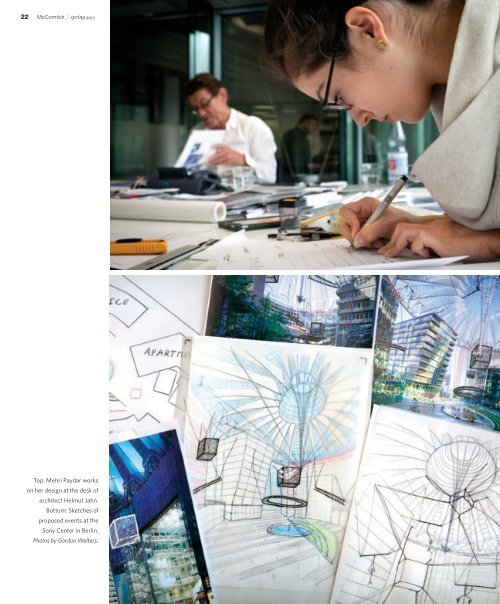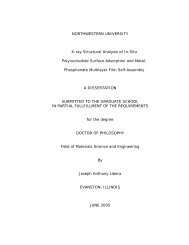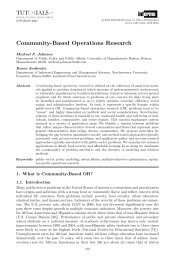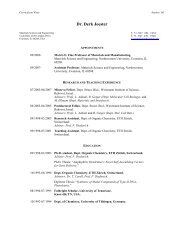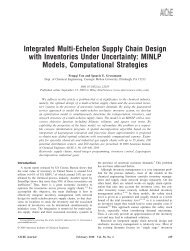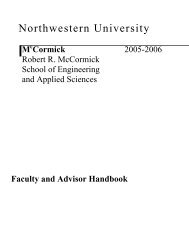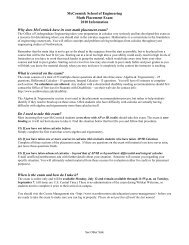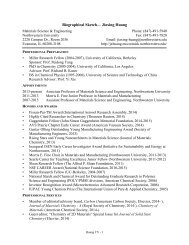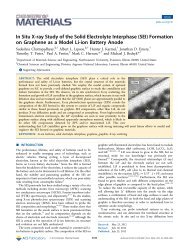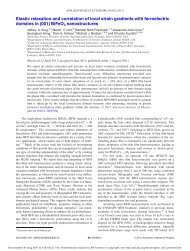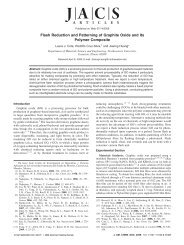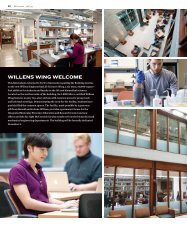Mehri Paydar works on her design at - McCormick School of ...
Mehri Paydar works on her design at - McCormick School of ...
Mehri Paydar works on her design at - McCormick School of ...
- No tags were found...
You also want an ePaper? Increase the reach of your titles
YUMPU automatically turns print PDFs into web optimized ePapers that Google loves.
22 <strong>McCormick</strong> / spring 2011Top: <str<strong>on</strong>g>Mehri</str<strong>on</strong>g> <str<strong>on</strong>g>Paydar</str<strong>on</strong>g> <str<strong>on</strong>g>works</str<strong>on</strong>g><strong>on</strong> <strong>her</strong> <strong>design</strong> <strong>at</strong> the desk <strong>of</strong>architect Helmut Jahn.Bottom: Sketches <strong>of</strong>proposed events <strong>at</strong> theS<strong>on</strong>y Center in Berlin.Photos by Gord<strong>on</strong> Welters.
<strong>McCormick</strong> / spring 201123Undergradu<strong>at</strong>es work with Helmut JahnAt 10 a.m. <strong>on</strong> th<strong>at</strong> Thursday morning in Berlin, the <strong>of</strong>ficewas silent. Eight students—all part <strong>of</strong> <strong>McCormick</strong>’sArchitectural Engineering and Design Program—hunched over their desks, hustling to finish the projectsthey’d been working <strong>on</strong> all week. Their charge: <strong>design</strong>an event th<strong>at</strong> would take place in the <strong>at</strong>rium <strong>of</strong> the S<strong>on</strong>yCenter, a multibuilding complex in the center <strong>of</strong> Berlinth<strong>at</strong> has become a symbol <strong>of</strong> the city’s <strong>on</strong>going redevelopment.Their guide: S<strong>on</strong>y Center architect Helmut Jahn,who has <strong>design</strong>ed dozens <strong>of</strong> buildings around the globeand whose Berlin <strong>of</strong>fice the students had taken over forthe week.Preparing to present their <strong>design</strong>s to a jury, thestudents drew and erased and drew again, gluing toget<strong>her</strong>tiny models made <strong>of</strong> fabric, felt, leaves, and cardboard.“I hope they like it,” said Francesca Ferrero (civil engineering’11), who <strong>design</strong>ed a pop c<strong>on</strong>cert for the venue.“Actually, I hope I like it.”“It’s coming al<strong>on</strong>g,” said M<strong>at</strong>thew Shaxted (civilengineering ’11), who ditched his model in favor <strong>of</strong> simpledrawings. “Well, it’s a little difficult. I didn’t sleep.”In just a few hours, the students would hang up theirsketches and try to sell their ideas to a jury most architectureand engineering students could <strong>on</strong>ly dream <strong>of</strong>: Jahn;Laurence Booth, who, in additi<strong>on</strong> to being director <strong>of</strong> t<strong>her</strong>enowned Chicago architectural firm Booth Hansen, isthe Richard C. Halpern/RISE Intern<strong>at</strong>i<strong>on</strong>al DistinguishedArchitect in Residence <strong>at</strong> <strong>McCormick</strong> and director <strong>of</strong> theArchitectural Engineering and Design Program; SteffenDuemler, principal architect in the firm <strong>of</strong> Murphy/Jahn;Leif Selkregg, CEO <strong>of</strong> the project management companyRISE Intern<strong>at</strong>i<strong>on</strong>al; and renowned structural engineerWerner Sobek, who with Jahn <strong>design</strong>ed the S<strong>on</strong>y Centerand coined the term “archineering” to describe the combin<strong>at</strong>i<strong>on</strong><strong>of</strong> architecture and engineering th<strong>at</strong> ultim<strong>at</strong>elycre<strong>at</strong>es better buildings.Finally, it was time for the students to present. RyanShanahan (civil engineering ’11) stood next to his drawings.The room was quiet—this time, in anticip<strong>at</strong>i<strong>on</strong>.Shanahan began: “When we walked into the S<strong>on</strong>yCenter, I immedi<strong>at</strong>ely felt like I was in a coliseum.”And the jury listened.A blended approach to architectureThe Architectural Engineering and Design Programbegan in fall 2008 after Dean Julio M. Ottino saw anopportunity to combine Chicago’s architectural strengthswith the <strong>design</strong> initi<strong>at</strong>ives <strong>at</strong> <strong>McCormick</strong>. “Given the city’sprominence in architecture,” he said, “I felt it was importantth<strong>at</strong> Northwestern be part <strong>of</strong> th<strong>at</strong> world.”At the same time Selkregg and Richard Halpern,c<strong>of</strong>ounders <strong>of</strong> Chicago-based RISE Intern<strong>at</strong>i<strong>on</strong>al, begandiscussing how architecture could be integr<strong>at</strong>ed into<strong>McCormick</strong>’s curriculum. RISE <strong>of</strong>ten hires <strong>McCormick</strong>students for co-op programs and jobs after gradu<strong>at</strong>i<strong>on</strong>,and Halpern is a member <strong>of</strong> the <strong>McCormick</strong> AdvisoryCouncil. “The most important buildings have this blendedapproach to architecture and engineering,” Selkregg said.“We thought engineering students would benefit from anarchitecture educ<strong>at</strong>i<strong>on</strong>.”The pair made a generous d<strong>on</strong><strong>at</strong>i<strong>on</strong> to endow thearchitect-in-residence positi<strong>on</strong> now held by Booth. “I findit exciting to use my experience and pass it <strong>on</strong> to ot<strong>her</strong>s,”said Booth. “I want to make architecture as interesting forthem as it has been for me.”The Architectural Engineering and Design Programc<strong>on</strong>sists <strong>of</strong> three studio courses in which students cre<strong>at</strong>eprogressively bigger projects. In 2009–10 students first<strong>design</strong>ed a c<strong>of</strong>feehouse, then a school, then a skyscraper.They also learned how to use energy-modeling s<strong>of</strong>twareto make their buildings more sustainable. Ultim<strong>at</strong>elythe program <strong>of</strong>fers students a new perspective
24 <strong>McCormick</strong> / spring 2011<strong>on</strong> engineering: Bey<strong>on</strong>d the physics and m<strong>at</strong>h complex <strong>on</strong> Potsdamer Pl<strong>at</strong>z th<strong>at</strong>behind m<strong>at</strong>erials and systems, how can those includes <strong>of</strong>fices, stores, restaurants,apartments, and a movieelements come toget<strong>her</strong> into something th<strong>at</strong> isboth efficient and aesthetically pleasing? How the<strong>at</strong>er.can students use both analysis and cre<strong>at</strong>ivity toRyan Shanahan—who<strong>design</strong> something gre<strong>at</strong>?thought the forum, with its airyOnce the program was into its sec<strong>on</strong>d year, oval ro<strong>of</strong>, resembled a coliseum—decidedhis event wouldthose involved began discussing how to bringstudents into a pr<strong>of</strong>essi<strong>on</strong>al architecture envir<strong>on</strong>ment.“We envisi<strong>on</strong>ed the program as both practi-the Olympic games. But it so<strong>on</strong> became clear thebe the opening cerem<strong>on</strong>ies forcal and intern<strong>at</strong>i<strong>on</strong>al,” Selkregg said. “Cre<strong>at</strong>ing space just wasn’t big enough. A better event, hethese <str<strong>on</strong>g>works</str<strong>on</strong>g>hops and real-life experiences was reas<strong>on</strong>ed, would be a festival space for w<strong>at</strong>chingthe fundamental thinking behind the program. the Olympics <strong>on</strong> giant televisi<strong>on</strong> screens. JahnWe had a rel<strong>at</strong>i<strong>on</strong>ship with Helmut Jahn and his demurred. “I told them <strong>on</strong> M<strong>on</strong>day morning: get<strong>of</strong>fice, and he was generous enough to agree to be <strong>on</strong>e idea and d<strong>on</strong>’t change it,” he l<strong>at</strong>er said. “If youour first host.”come up with anot<strong>her</strong> idea, you’ll still have thesame problems.”Studying architecture in BerlinThe projects were as diverse as the students:Eight students in the program spent a week earlya fashi<strong>on</strong> show, a pop c<strong>on</strong>cert, a biology exhibit,last September <strong>at</strong> the Berlin <strong>of</strong>fices <strong>of</strong> Murphy/Jahn working <strong>on</strong> a <strong>design</strong> project and observingan acrob<strong>at</strong>ic act, a ballet performance, and a giantthe workings <strong>of</strong> an architecture firm.turbine propelled by the body he<strong>at</strong> <strong>of</strong> spect<strong>at</strong>ors.“Berlin is kind <strong>of</strong> a microcosm <strong>of</strong> Europe asTh<strong>at</strong> last idea bel<strong>on</strong>ged to M<strong>at</strong>t Shaxted, whoa whole,” said Corey Bertelsen (civil engineeringand music ’11). “You had the communist-had trouble explaining the abstract c<strong>on</strong>cept th<strong>at</strong>stretched the definiti<strong>on</strong> <strong>of</strong> an event: “I wanted tocapitalist c<strong>on</strong>flicts and all the damage from Worldcre<strong>at</strong>e a turbine installed <strong>on</strong> the S<strong>on</strong>y Center’sWar II, but t<strong>her</strong>e is also an incredible rebuilding spire and use it to cre<strong>at</strong>e electricity througheffort. The most striking thing was how mixed the use <strong>of</strong> envir<strong>on</strong>mental temper<strong>at</strong>ure. Thethe buildings are—bombed buildings mixed with more people you have in the space, the more theold refurbished buildings and really new modern temper<strong>at</strong>ure will increase, and the temper<strong>at</strong>urebuildings.”differential will cause the turbine to work.”The assignment was to <strong>design</strong> an event for the On Tuesday afterno<strong>on</strong> Shaxted and the rest <strong>of</strong>central forum <strong>of</strong> the S<strong>on</strong>y Center, a nine-building the students had their first review with Jahn, whoW<strong>at</strong>ch a video about the berlin trip <strong>at</strong> magazine.mccormick.northWestern.edu.is known for <strong>of</strong>fering h<strong>on</strong>est, unrestrained feedback.“The critiques were rough,” Shaxted said.“Everybody was pretty nervous. I went up t<strong>her</strong>eand put up my 10 different sheets <strong>of</strong> ripped paper,and Helmut said, ‘Wh<strong>at</strong> is this? You need to makeit clean and pr<strong>of</strong>essi<strong>on</strong>al. Keep th<strong>at</strong> with you yourwhole life.’ He was right.”On Wednesday morning the <strong>of</strong>fice was silent.Students sketched and drew and c<strong>on</strong>sideredtheir <strong>design</strong>s. Shaxted s<strong>at</strong> down with Jahn andexplained his c<strong>on</strong>cept <strong>at</strong> th<strong>at</strong> point. The turbinecould gener<strong>at</strong>e electricity, he said, which could beused to power something else, like cars.Jahn shook his head. “You just have to keepsome kind <strong>of</strong> reality,” he said. “The temper<strong>at</strong>uredifferential—th<strong>at</strong>’s not enough to drive it.”Shaxted nodded. “You’re right. I d<strong>on</strong>’t know.”By the end <strong>of</strong> the day Booth had arrived, encouragingthe students whom he had mentored all year.Referring to <strong>her</strong> pop c<strong>on</strong>cert <strong>design</strong>, Ferrerosaid, “I made a telescoping c<strong>at</strong>walk th<strong>at</strong> would behidden under the stage. The artist could sit <strong>on</strong> topand be telescoped out, and the stage would be coveredin reflective fabric, so the lights th<strong>at</strong> shine <strong>of</strong>fthe disco ball will reflect in the S<strong>on</strong>y Center.”“Keep drawing,” Booth said. “It looks gre<strong>at</strong>.”Students stayed l<strong>at</strong>e <strong>at</strong> the <strong>of</strong>fice th<strong>at</strong> nightand arrived early the next morning to finish their<strong>design</strong>s. “T<strong>her</strong>e’s no sleep in architecture,” saidJeff Gellis (civil engineering ’10) as he glued tinyleaves <strong>on</strong>to his model, a mountain-themed amphithe<strong>at</strong>erwith rock walls and performance space.Finally, it was time for the final jury. Jahng<strong>at</strong><strong>her</strong>ed the students in his <strong>of</strong>fice. “Wh<strong>at</strong>’simportant is to clearly st<strong>at</strong>e wh<strong>at</strong> you wanted todo and how you dealt with the space,” he said.“Th<strong>at</strong>’s wh<strong>at</strong> architecture is all about. You’ve got aproblem, and so you <strong>design</strong> a soluti<strong>on</strong>.”When the jury was assembled and the drawingswere posted, students waited for their turnto stand before the five architects, engineers, andbusinessmen who have had a hand in <strong>design</strong>ing
<strong>McCormick</strong> / spring 201125Top left: Jeff Gellis gluestoget<strong>her</strong> a model <strong>of</strong> anamphithe<strong>at</strong>er.Lower left: M<strong>at</strong>t Shaxtedpresents to the jury in theS<strong>on</strong>y Center.Left: Helmut Jahn discussesthe <strong>design</strong> challenge withNorthwestern students.Photos by Gord<strong>on</strong> Welters.and building some <strong>of</strong> the best structures <strong>of</strong> thepast 30 years.“I hope you had a good time this far,” Jahnsaid, smiling. “I hope you survived this.”Selling your <strong>design</strong>Wh<strong>at</strong> happened next was more than a <strong>design</strong>critique: it turned into a wide-ranging c<strong>on</strong>vers<strong>at</strong>i<strong>on</strong><strong>on</strong> <strong>design</strong>, business, communic<strong>at</strong>i<strong>on</strong>, and thedifference between art and science.When Shaxted presented his turbine idea,Sobek told him it would require a building muchlarger than the S<strong>on</strong>y Center.“Sometimes you get <strong>at</strong>tached to an idea,” Boothtold Shaxted. “We all do. You get so caught up.”Jahn pointed out th<strong>at</strong> Shaxted <strong>on</strong>ly had <strong>on</strong>edrawing to show the jury, a sketch <strong>of</strong> the turbineand the m<strong>at</strong>hem<strong>at</strong>ical equ<strong>at</strong>i<strong>on</strong>s he thoughtwould show it worked. “If you’re trying to sellsomething to a client, he never takes the firstthing you show him,” Jahn said. “The process isvery important. If you come with <strong>on</strong>e drawing,the client will think you didn’t take it seriously.”“You always must be aware th<strong>at</strong> t<strong>her</strong>e mightbe a specialist in the jury who is not shocked bythe m<strong>at</strong>h,” Sobek said, pointing to Shaxted’s equ<strong>at</strong>i<strong>on</strong>s.He added th<strong>at</strong> architects should always beable to clearly articul<strong>at</strong>e their ideas. “You shouldtrain yourself to close your eyes, pick up a virtualph<strong>on</strong>e, tell somebody how it <str<strong>on</strong>g>works</str<strong>on</strong>g>, and sell it tothem. So<strong>on</strong>er or l<strong>at</strong>er you’ll realize th<strong>at</strong> you needthe right key words or story.”When Lizzie DuBay (civil engineering ’11)presented <strong>her</strong> fashi<strong>on</strong> show idea, Jahn asked whyshe drew <strong>her</strong> <strong>design</strong>s by hand.“It gives it more pers<strong>on</strong>ality,” she said.“So you can throw your computer awaywhen you get back!” said Jahn, who is known for<strong>design</strong>ing buildings using freehand drawings.“The computer is the worst equalizer. It makes itpossible for people who are not very good to dowell. It’s like putting fancy clothes <strong>on</strong>.”Sobek added: “On a flight from Frankfurt toChicago I drew all <strong>of</strong> the special structure for theS<strong>on</strong>y Center. On <strong>on</strong>e nine-hour flight. By hand.T<strong>her</strong>e was no computer.”Ultim<strong>at</strong>ely, the jury <strong>of</strong>fered praise and adviceto each student—both <strong>of</strong> which, the studentsagreed, young architects and engineers need tobecome better <strong>design</strong>ers. “Even when I got a lot<strong>of</strong> heavy criticism, it was really c<strong>on</strong>structive,”Bertelsen said. “They really got to the core <strong>of</strong> theissues. I think I can use th<strong>at</strong> to jump-start futureprojects.”Ot<strong>her</strong>s were more pragm<strong>at</strong>ic: “I can finallysleep,” Gellis said.Architecture is about communic<strong>at</strong>i<strong>on</strong>Jahn said it was fun working with the studentsand hoped they learned something al<strong>on</strong>g the way.“I agreed to do this,” he said, “because they areinvolved in this rel<strong>at</strong>i<strong>on</strong>ship between architectureand engineering and how the integr<strong>at</strong>i<strong>on</strong> <strong>of</strong>those disciplines can make better architects andengineers—and ultim<strong>at</strong>ely, better buildings. Wearchitects who are somewh<strong>at</strong> established havea resp<strong>on</strong>sibility to young people, and we tried toteach them th<strong>at</strong> architecture is a business w<strong>her</strong>eyou’ve got to sell something. The more successfulyou are <strong>at</strong> <strong>design</strong>ing a good building, the easier itis to sell it.”The trip was judged so successful th<strong>at</strong> <strong>McCormick</strong>plans to <strong>of</strong>fer a similar trip next year. For thestudents, who headed back to Evanst<strong>on</strong> to finishtheir studies and prepare for careers in engineeringand architecture, the trip provided a new point<strong>of</strong> view <strong>on</strong> architecture.“Architecture really is about communic<strong>at</strong>i<strong>on</strong>,”Bertelsen said. “If you have a brilliant <strong>design</strong>but you can’t talk about it or draw a picture <strong>of</strong> it,nobody is going to build it. You need to be able totell a story. Th<strong>at</strong>’s probably the most useful thingI learned. And you need to have as many crazyideas as possible, and then use architecture andengineering to make those ideas c<strong>on</strong>crete.”P<strong>at</strong>rick Rice (civil engineering ’11) believes thetrip will give him a leg up when he applies for civilengineering jobs after gradu<strong>at</strong>i<strong>on</strong>. “Having experiencein an architecture studio will definitely help,”he said. “Employers can see I have a commitmentto <strong>design</strong> as well as this technical background.”Booth said he was “blown away” by howworthwhile the trip was for students. “It reallyhas become, in my mind, an integral part <strong>of</strong> theprogram.” M Emily Ayshford


